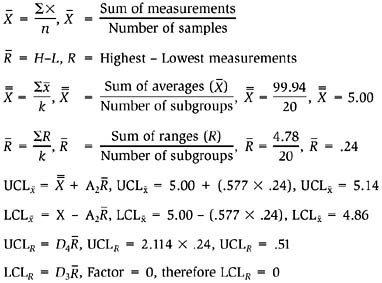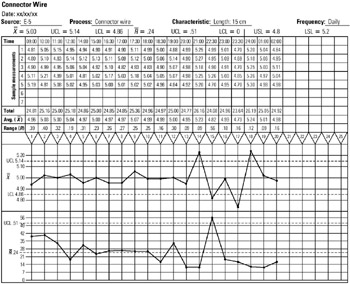Tool 42: Control Chart - -R (Variable)
Tool 42: Control Chart— -R (Variable)
-R (Variable)
| AKA | N/A |
| Classification | Analyzing/Trending (AT) |
Tool description
A control chart is a graph that plots randomly selected data over time in order to determine if a process is performing to requirements or is, therefore, under statistical control. The chart displays whether a problem is caused by an unusual or special cause (correctable error) or is due to chance causes (natural variation) alone.
Typical application
-
To determine if a process is performing to upper and lower control-limit requirements (process is kept in control).
-
To monitor process variations over time, with regard to both special or chance causes.
-
To identify opportunities for improving quality and to measure process improvement.
-
To serve as a quality measurement technique.
Problem-solving phase
| → | Select and define problem or opportunity |
| → | Identify and analyze causes or potential change |
| Develop and plan possible solutions or change | |
| → | Implement and evaluate solution or change |
| → | Measure and report solution or change results |
| Recognize and reward team efforts |
Typically used by
| 2 | Research/statistics |
| Creativity/innovation | |
| 4 | Engineering |
| Project management | |
| 1 | Manufacturing |
| Marketing/sales | |
| Administration/documentation | |
| Servicing/support | |
| 3 | Customer/quality metrics |
| Change management |
before
-
Variance Analysis
-
Sampling Methods
-
Observation
-
Checksheet
-
Events Log
after
-
Process Capability Ratios
-
Standard Deviation
-
Descriptive Statistics
-
Process Analysis
-
Work Flow Analysis (WFA)
Notes and key points
| Types of Control Charts | |
|---|---|
| Data Required | For Specific Chart |
| Quantitative Variable Data |
|
| Qualitative Attribute Data |
|
Most commonly used charts:
| †For variable data: | |
| ‡For attribute data: | c Chart |
| ‡‡For attribute data: | p Chart |
Note: For a description of other charts refer to a reference on statistical process control (SPC).
-
 -R Chart (variable data)
-R Chart (variable data) -
Sample data: Random sampling, minimum (20) samples, minimum (5) data points in each subgroup.
-
Calculations: See
 -R Chart example
-R Chart example
| Table of Factors for | ||||
|---|---|---|---|---|
| Data Points in Subgroup (n) | Factors for | Factors for R Chart | ||
| A2 | Upper-D3 | Lower-D4 | ||
| 2 | 1.880 | 0 | 3.268 | |
| 3 | 1.023 | 0 | 2.574 | |
| 4 | .729 | 0 | 2.282 | |
| 5 | .577 | 0 | 2.114 | |
| 6 | .483 | 0 | 2.004 | |
| 7 | .419 | .076 | 1.924 | |
| 8 | .373 | .136 | 1.864 | |
| 9 | .337 | .184 | 1.816 | |
| 10 | .308 | .223 | 1.777 | |

Step-by-step procedure
-
STEP 1 Determine the type of variance control chart to be used. See example Connector Wire (variables control chart—type
 -R).
-R). -
STEP 2 Collect at least 20 samples of data, 5 measurements per sample. Sampling should be random and according to a set frequency over a period of time.
-
STEP 3 Prepare a type
 -R Chart and record collected data as shown. See example chart.
-R Chart and record collected data as shown. See example chart. -
STEP 4 After all 20 subgroups (samples) have been recorded, perform all required calculations. See notes and key points above for example.
-
STEP 5 Plot and connect plotted points to draw trendlines. Verify that trendline points reflect recorded averages (
 ) and ranges (R).
) and ranges (R). -
STEP 6 Analyze plotted data for significant variance or patters.
Example of tool application

EAN: 2147483647
Pages: 326